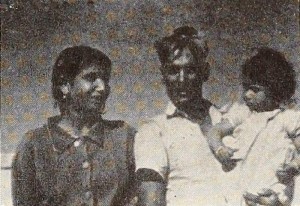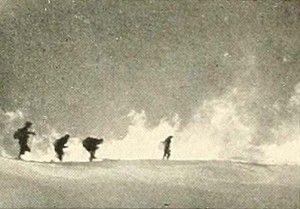
"The Hong Kong of today is still one of the most beautiful cities in the world, but under fer facade of sparkling beauty lies poverty, disease, and hunger. Crowded to the point of bursting, housing, sanitation and food cannot keep pace with the stream of humanity pouring into the city. Beautifully photographed, we see the people living their daily lives in make-shift shelters, on sampans, on top of buildings and on every square foot of available space. You can see the hunger and fear in their eyes, yet there is smiling acceptance, with hope for the future. The narrator's voice is full of compassion, yet recognizes the dignity of these work-worn, deprived people. Seeing the children, in their happy innocence and lack of concern for a desperate situation, "Hong Kong can break your heart!" PSA Journal, Oct. 1963, 40.
"Hong Kong. There have been films and films about Hong Kong, but this one tops them all. Jack Babkes of Brooklyn takes you on a 12.5 minute tour of one of the most interesting spots in the world. Naturally it's in entertaining color, very entertaining otherwise, too. You'll feel that "you-have-been-there" " PSA Journal, Nov. 1969, 57.
"Isle of the Gods is a visit to the Island of Bali and a closeup look at the people, their beliefs, their superstitions, and their way of life. Bali is changing. No longer is this a primitive isle, for the constant encroachment of civilization has made its mark here as well as elsewhere in the South Seas" PSA Journal, Aug. 1967, 37.

"Oscar H. Horovitz, you may recall, already has told in words (see Israel Invites, March Movie Makers) about his month-long visit of last year to this newest of the world's democracies. In The Israeli Story, with all personal references excised, he now sets forth film a record of this hard-won republic he found it. Covered, in step-by-step reporting, are its polyethnic citizens, its social, economic and educational centers, and, briefly, its hopes for the future. Supplementing this visual reportage there is a technically excellent magnetic recording on film, in which music is used sparingly and the narrative is both written and delivered with restraint. As such, The Israeli Story is a competent documentary record which should serve (and, in fact, has served) the public relations program of the new Jewish state effectively. An objective observer of the film, however, draws from it little if any of the emotional uplift which is eagerly hoped for by every sympathetic viewer." Movie Makers, Dec. 1952, 341.
"'Japan and Its People,' Dr. Roy Gerstenkorn's educational class winner, was a pictured visit to the homes and temples of Japan. Ignoring the cities in his search for the story of the Japan that is not known to the average visitor the doctor penetrated the towns and smaller communities. His picture was awarded a high rating on its photography as well as on his treatment of the subject. After the showing of this picture before the Los Angeles Motion Picture Forum last summer the local school authorities requested and received permission from the doctor to make a duplicate of it for school purposes." American Cinematographer, Jan. 1938, 27-28.
"Ship sails from Chicago, visits Japan's ports, cities, villages, etc. Views of modern with traditional." UC San Diego Library.
Amateur news film about the outbreak of the Manchurian Incident in 1931. "Jikyokubin consisted of a set of eight news films, including titles such “Jihen hassei chokugo no Hōten” (Mukden right after the Incident), “Aikokugō o mukau!” (Welcoming patriotic aircrafts!), and “Manshūkoku no kensetsu o iwau” (Celebrating the establishment of Manchukuo). Six out of the eight films were made by Imai, and the rest were shot by two other members of the small-gauge film society at Manchuria Medical College." - Noriko Morisue, "Filming the Everyday: History, Theory, and Aesthetics of Amateur Cinema in Interwar and Wartime Japan" (Yale University: PhD Dissertation, 2020): 188.
"The Legend of San San Ku was a practically unanimous choice as winner of the top award with its story of a Japanese legend. If the credits were to be removed from the beginning of this film, it would be hard to believe that it was not made in Japan. It was a very ambitious production for a crew of amateurs to undertake, and they came through with flying colors. Here's 20 minutes of Japan that is delightful to experience" PSA Journal, Oct. 1968, 48.
"Monkey's of the Snow Mountain is a touching film of northern Japan produced by Masatoshi Okochi of Japan. You will never believe how sorry you can feel for a tribe of monkeys in 15 minutes of snow, snow and more snow. The film is in color, mostly white. It took four years to film the seasonal cycle in its fullest. Here we have suffering not only by the subjects of the film but by the film maker as well. In spite of that, you'll enjoy it" PSA Journal, Nov. 1969, 57.

"A down mountain ski run, etched against a filtered sky and set in a world of fantastic snow shapes and incredible beauty, is the theme of Mount Zao, which was filmed on the Japanese mountain of that name. Khoji Tsukamoto has mastered the technique of back lighting the dramatic turns, stems and jumps of a down mountain run so that they are framed against luminous clouds of powdered snow. The ski runners are always preceded by an ubiquitous cameraman who has invariably chosen the most effective angle for each scene of his closely knit sequences. The result is as smooth a picture of skiing as the screen has seen. In sequencing, editing and the nuances of tempo, this film is near the top. And particularly praiseworthy is the way in which the cameraman has involved backgrounds of astonishing natural beauty with foregrounds of interest compelling action." Movie Makers, Dec. 1937, 603, 626.
Total Pages: 6